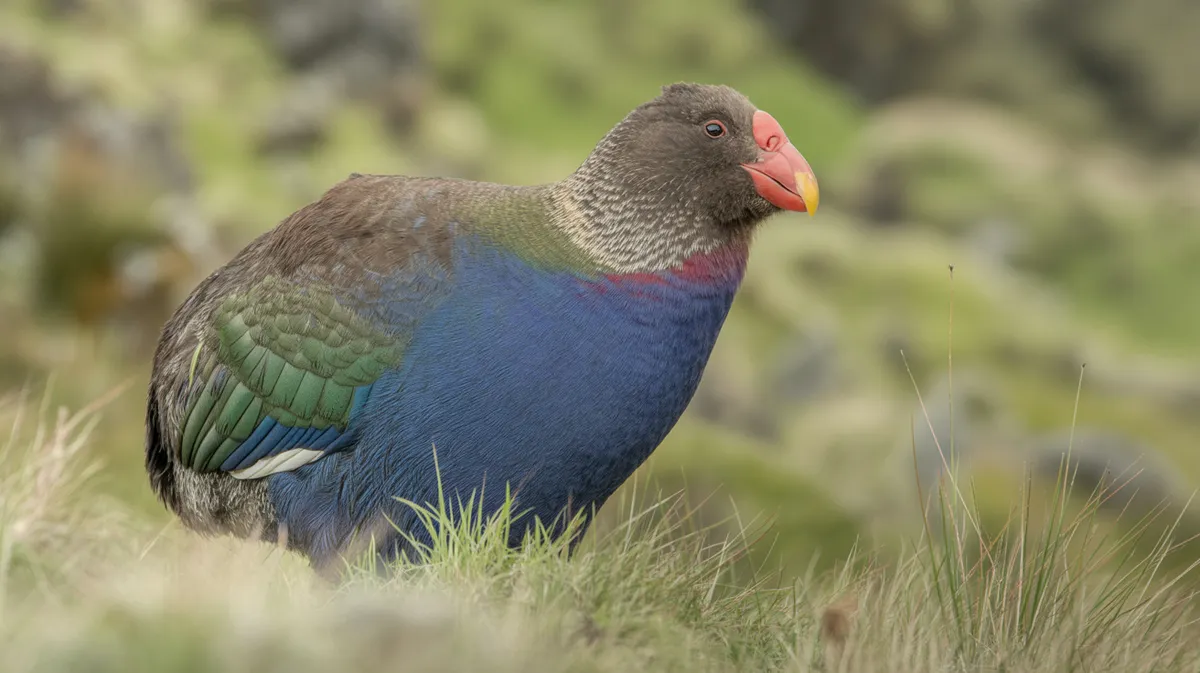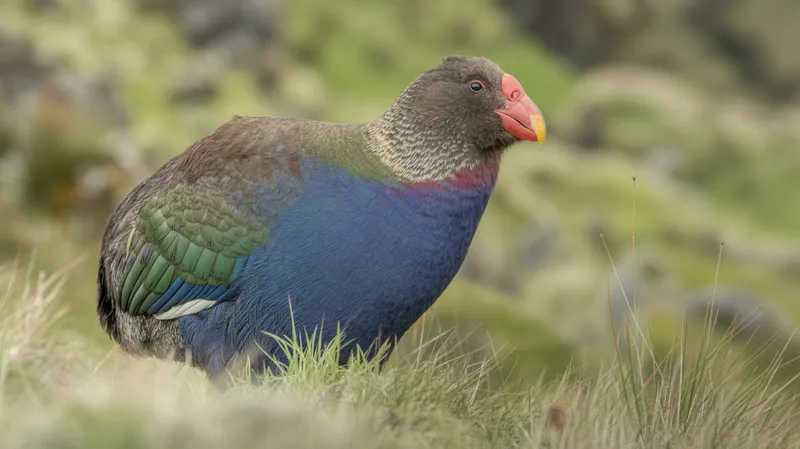
South Island Takahe
Porphyrio hochstetteri

Meet the South Island Takahe
The South Island Takahe is a large, flightless bird native to New Zealand, notable for its striking blue and green plumage, robust red beak, and sturdy legs. Once thought extinct, it was dramatically rediscovered in 1948 in the remote Murchison Mountains. Takahē are primarily ground dwellers, well-adapted to the alpine grasslands where they forage for grasses and shoots. With a calm demeanor, these birds form strong pair bonds and have a slow reproductive rate, contributing to their vulnerability. Today, they are a flagship species for New Zealand conservation efforts.
Classification
Bird
Habitat
Alpine grasslands
Diet
Herbivore
Lifespan
12-20 years
Conservation
Endangered
Weight
2.3–3.7 kg
📖Fascinating Facts
Flightless Bird
The takahē is completely flightless, having evolved strong legs and reduced wings suited for a terrestrial lifestyle.
Grass Specialist
Its diet consists mainly of tussock grasses, especially the seeds and softer bases of these alpine plants.
Rediscovered Species
Thought extinct for over 50 years, the takahē was dramatically rediscovered in 1948 by Dr. Geoffrey Orbell in the remote Fiordland mountains.
📋Detailed Description
The South Island Takahe (Porphyrio hochstetteri) is a robust, flightless rail measuring 50–63 cm in length and weighing between 2.3 and 3.8 kg, with males generally larger than females. Its plumage is a striking iridescent blend of deep blue, turquoise, and olive-green, with a prominent scarlet frontal shield and massive, laterally compressed red bill adapted for cutting tough vegetation. The wings are small and rounded, rendering the species incapable of flight, while the legs are strong and pinkish-red, suited for traversing rugged alpine terrain. Takahe have large, expressive eyes and a short tail, often flicked as a signal during social interactions. Their skeletal structure reveals adaptations for a terrestrial lifestyle, including a robust pelvic girdle and reduced keel on the sternum. Socially, takahē are monogamous, forming long-term pair bonds and defending territories year-round. They are primarily crepuscular, foraging at dawn and dusk, and exhibit a calm, deliberate gait. The species is known for its low reproductive rate, typically raising only one or two chicks per year, and displays extended parental care, with both sexes involved in incubation and chick-rearing. Their vocalizations are varied, including booming calls used for territory defense and softer contact calls within family groups.
💡 Did you know?
The South Island Takahe is one of the rarest birds in the world, with only a few hundred individuals remaining in the wild and in managed reserves.
🔬Research & Sources
Wikipedia Summary
The South Island takahē is a flightless swamphen indigenous to New Zealand and the largest living member of the rail family. It is often known by the abbreviated name takahē, which it shares with the recently extinct North Island takahē. The two takahē species are also known as notornis.
Last Modified: 6/9/2025
🎭Behavior & Social Structure
South Island Takahē are diurnal but most active during the early morning and late afternoon. They are exclusively herbivorous, feeding primarily on tussock grasses (notably Chionochloa species), extracting the nutritious bases and seeds with their powerful bills. Foraging is methodical: birds grasp a grass blade, strip away the outer layer, and consume the soft inner tissue. Takahē are territorial, with pairs or small family groups maintaining and defending territories of 10–50 hectares, marked by vocalizations and physical displays. Social interactions are generally peaceful within family units but can become aggressive during territorial disputes. They communicate through a repertoire of calls, including loud 'booms' and softer 'coos.' Daily routines include foraging, preening, dust-bathing, and resting in sheltered areas. During the breeding season, pairs engage in mutual preening and courtship feeding.
👶Reproduction & Life Cycle
Takahē are monogamous, forming stable pair bonds that often persist for life. Breeding occurs from October to January, coinciding with the Southern Hemisphere spring and summer. Nests are constructed on the ground, hidden among dense tussocks or shrubs, and lined with grass. The female typically lays 1–3 eggs per clutch (average 2), which are incubated by both parents for 30–32 days. Chicks are precocial, hatching with dark down and open eyes, and are brooded and fed by both parents. Fledging occurs at 70–90 days, but juveniles may remain with parents for up to a year, assisting in subsequent broods. Reproductive success is low, with high chick mortality due to predation and environmental factors.
🛡️Adaptations & Survival
The South Island Takahē exhibits several key adaptations for a flightless, terrestrial existence in alpine grasslands. Its large, strong bill is specialized for shearing and stripping tough grasses, while its robust legs and feet enable efficient movement through dense vegetation and uneven terrain. The reduction of flight muscles and the keel on the sternum reflects its loss of flight. Plumage coloration provides camouflage among tussocks and subalpine vegetation. Behaviorally, takahē have evolved a low reproductive rate but extended parental care, maximizing the survival of limited offspring. Their vocal communication is adapted for long-distance signaling in open habitats.
📚Research Sources
🎨Cultural Significance
The takahē holds significant cultural value for Māori, who traditionally regarded it as a taonga (treasure) species. It features in oral histories and legends, symbolizing endurance and the unique biodiversity of Aotearoa (New Zealand). The dramatic rediscovery in 1948 captured national attention and made the takahē a flagship for conservation, featuring in educational programs, tourism, and as an emblem of New Zealand’s commitment to preserving endemic wildlife.
🔬Recent Research & Discoveries
Recent research has focused on genetic diversity, revealing a genetic bottleneck due to the small founder population. Studies on foraging ecology have informed habitat management, highlighting the importance of specific tussock species. Ongoing telemetry and camera-trapping projects monitor movements, breeding success, and predator interactions. Advances in captive breeding and artificial incubation have improved chick survival rates. Conservation genetics and population viability analyses are guiding translocation and management strategies. Notably, a 2021 study used genome sequencing to assess inbreeding and inform future breeding plans.
🎥Wildlife Videos

Project Takahe "1980"
This giant flightless rail was thought to be extinct until dramatically rediscovered in remote Fiordland in 1948. Since their ...
WiLD Studios

Takahe Champion
There aren't many thirteen year olds who can say they're helping to save a species, but Sophie Smith from Southland can.
BushTellyTV

A Rare Pair of Chicks for the Exotic and Endangered Takahe 🐥 Into The Wild New Zealand | Smithsonian
One of the rarest birds in existence, the flightless Takahe has found a new lease of life in the Orokonui ecosanctuary. In this clip, a ...
Smithsonian Channel

Endangered Animals: Finding Takahē (Nature Documentary)
Finding endangered animals like the Takahē (endangered bird species) is a pretty special nature moment, especially as as they ...
Emma Blackwell

Critically Endangered South Island Takahe of New Zealand
Once though extinct this large flightless bird was rediscovered in 1948. Now only found in the wild in the Murchison Mountains ...
gardening with birds

Meet the Locals: Takahē
Season 1, episode 15: In this video you'll learn about the takahē. Once thought extinct, they were rediscovered in 1948. Though ...
Department of Conservation
🌍Habitat Information
The South Island Takahe typically inhabits Alpine grasslands environments. South Island Takahes have adapted to their environments with specialized features and behaviors.
Primary Habitat:
Alpine grasslands
More detailed habitat information will be available soon.
🛡️Conservation Status
The South Island Takahe is currently classified as Endangered. Conservation efforts are crucial for preserving this species for future generations.
Common Threats:
- 🏠Habitat loss and fragmentation
- 🌡️Climate change impacts
- 🎯Hunting and poaching
- 🏭Human-wildlife conflict
⚠️Threats & Conservation Challenges
The primary threats to the South Island Takahē are predation by introduced mammals (stoats, ferrets, cats), habitat loss and modification, and competition with introduced deer for food resources. The species is highly vulnerable due to its flightlessness, low reproductive rate, and small, fragmented population. Climate change poses additional risks by altering alpine ecosystems. Conservation challenges include maintaining genetic diversity, managing inbreeding, and ensuring suitable habitat. Intensive management, including predator control, translocation to predator-free islands, and captive breeding, has stabilized but not fully secured the population, which remains under 500 individuals as of 2023.
🔬Scientific Classification
Scientific Name
Porphyrio hochstetteri
Classification Hierarchy
🔍 About Taxonomic Classification
Taxonomic classification is a hierarchical system used by scientists to classify and organize living organisms based on shared characteristics and evolutionary relationships.
The system moves from broad categories (Kingdom) to increasingly specific ones, with each animal's scientific name typically consisting of its Genus and species.
📝Community Notes
Share your observations and insights about the South Island Takahe with our community of wildlife enthusiasts.
Join Our Community
Sign in to share your observations and connect with fellow wildlife enthusiasts.
Sign In to ContributeNo community notes yet
Be the first to share your observations about the South Island Takahe!
Explore South Island Takahe
Select a tab above to learn more about this amazing animal.
📸Photo Gallery
No photos available for this animal yet.
🌟Discover More Wildlife
Continue your journey of discovery with more fascinating animals from our database
